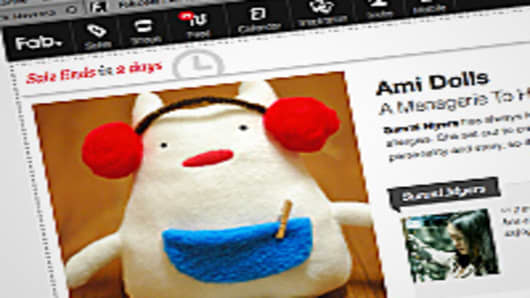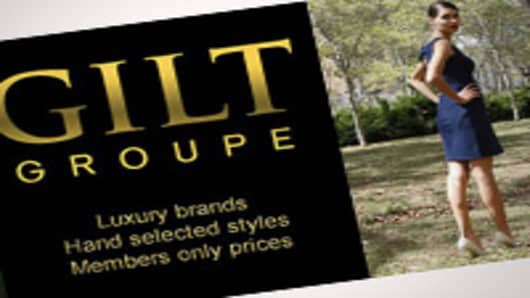Flash-sale websites such as Gilt Groupe and Ru La La were hailed as disruptors in the ecommerce space, but recently there’s been a bit of a disruption in their success story, prompting some to wonder if flash-sale sites are more of a marketing gimmick than a sustainable business model.
The sector, while still growing, is being shaken up by consolidation, layoffs and slowing growth rates. Many industry analysts suspect that will continue unless flash-sale sites adapt.
Take design shopping site Fab. The company was once lumped into the “flash-sale” genre, but Fab recently revamped its website putting the spotlight firmly on features that help shoppers share information about products with friends. The new design was most noteworthy for what it didn’t highlight: sales.
Fab CEO Jason Goldberg told TechCrunch that he never really thought of Fab as a flash-sale site. Still, when the site launched, it followed the typical flash sale formula: it was a members-only site that sold home décor pieces and other items for a limited time.
For Fab, the redesign was another step in the company’s evolution, spokeswoman Melissa Klein told CNBC.com. But for some critics, it could be another chance to question the flash-sale business model.
“We used flash sales as a way of selling and engaging our members,” Klein said. However, she explained that unlike sites like Gilt, there was never a focus on getting luxury products on the cheap and moving overstocked merchandise at Fab. Instead, Fab tried to cultivate an engaged membership who would come back to the site day after day to see the products the site featured.
“On any given day, a $5 set of animal magnets could be featured right next to a $5,000 Herman Miller chair,” Klein said. She added that design is the element that links the merchandise together.
Email Fatigue
One sign that the site has achieved its goal of building dedicated fans is the fact that more of the site’s traffic comes directly to the site rather than through emails that push people to the site.
Email fatigue is one of the biggest challenges flash-sale sites face. Emails are the primary way of disseminating deals, but after a while web shoppers can tune out and unsubscribe. This was even more true as more flash-sale sites came on the scene and as active shoppers subscribed to more than one flash-sale site.
“It has gotten to be an incredibly crowded marketplace, and there is the risk that all these offers can overload consumers,” said Stephen Wyss, a partner in the retail and consumer practice at BDO.
Wyss expects to see more consolidation in the space as players either merge or disappear.
Consolidation
This may be particularly true among flash-sale sites that have focused on luxury apparel and accessories. Sites like Gilt, Rue La La, Ideeli, and Nordstrom's HauteLook are competing not only against each other but also against prominent sales events at department stores, outlet stores like those operated by brands such as J. Crew and Ralph Lauren , off-price retailers such as TJ Maxx and Ross Stores as well as other ecommerce sites that do not incorporate flash-sale elements but offer discounts nonetheless such as TheOutNet, Piperlime and Yoox.
The limited quantities of merchandise and tight time limits create a sense of urgency that can goad consumers into making impulse purchases, but it only takes a few times before savvy consumers realize that they can often find the same merchandise for less elsewhere. High shipping costs and tough return policies also make flash-sale sites a less consumer-friendly option for some shoppers.
And it doesn’t help that with an improving economy, there are more retailers fighting to get the same merchandise to the same group of fashion-minded consumers.
“Luxury department stores are doing very well,” said Jill Puleri, vice president and global retail leader for Global Business Services at IBM. She explained that with U.S. consumer spending on the rise and growing luxury retail sales from Chinese customers, there isn’t as much need for flash sales as there had been during the recession in order to move stock.
Amazon Threat on the Horizon?
Puleri expects the situation will even get worse for flash-sale sites as Amazon builds its luxury apparel business.
“Department stores should take notice as well….They never thought of Amazon as a threat, but now they could be,” Puleri said.
Some flash-sale players are fighting back by expanding into new areas or honing their focus on niche businesses that may be more difficult for competitors to enter. A good example is the flash-sale sites that are targeted to parents of infants and young children.
According to Comscore, Zulily, which operates in this niche, had more than 2 million unique visitors in April, up 12 percent from a year ago. Smaller rival Totsy saw the number of unique visitors climb an eye-popping 1,140 percent to 687,000 during the same period.
“If you try to compete with Amazon, you are dead,” said Guillaume Gauthereau, co-founder & CEO of Totsy.
Gauthereau said that sites like Gilt wanted to have a broad audience, but shoppers went to their sites expecting that they would find the latest and the best luxury goods at steep discounts. “This is something you cannot sustain,” Gauthereau said. “You cannot because there are other people who want the same thing.”
Playing the Niche
In Totsy’s niche, the competition is very fragmented. There are few large retailers to compete with and there isn’t a well-established market to sell overstocked goods. Sites like Totsy and Zulily are helping to solve a problem that manufacturers of infant and children’s products had.
Wine is another category that has seen a lot of activity. One example is WinesTilSoldout, an online business started in 2006 — well before people starting discussing “flash sales.”
The owners of the business operated liquor stores in the Philadelphia area for decades, but then they began selling lots of wine, one at a time, until they were sold out on their website. The company’s well-established relationship with wineries, which was formed over the years running its retail stores, allowed the company to get the inventory it needed and sell it at prices that were about 30 percent to 70 percent off original retail prices.
Since the online business started, sales have grown between 20 percent and 50 percent each year, including in 2011, when sales grew about 50 percent. And the number of members who have joined the site also grew rapidly.
“It grew exponentially….It was very shocking,” said Elliot Arking, the company’s CEO and co-founder.
Despite the challenges that may be ahead, growth is still continuing for many flash-sale sites. Some observers expect that the companies that are growing more slowly are maturing and getting ready for their next stage of development.
According to Andrew Lipsman, vice president of industry analysis at ComScore, the early adopters were very fashion-forward women who could be counted on to share their experiences with others and bring them into the franchise.
“But there’s a much bigger market that didn’t necessarily adopt them earlier,” Lipsman said. “They’re slower to the adoption process, but as it catches on with the later adopters, there can be a more significant increase in growth.”
Questions? Comments? Email us at consumernation@cnbc.com. Follow Christina Cheddar Berk on Twitter @ccheddarberk.





